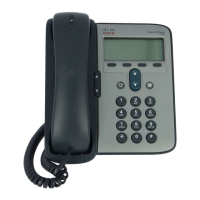Chapter 1 An Overview of the Cisco Unified IP Phone
Understanding the Requirements for Configuring and Installing Cisco Unified IP Phones
1-22
Cisco Unified IP Phone 7906G and 7911G Administration Guide for Cisco Unified CallManager 5.1
OL-11515-01
Security Restrictions
A user cannot barge into an encrypted call if the phone that is used to barge is not
configured for encryption. When barge fails in this case, a reorder tone (fast busy
tone) plays on the phone the barge initiator’s phone.
If the initiator phone is configured for encryption, the barge initiator can barge
into an authenticated or nonsecure call from the encrypted phone. After the barge
occurs, Cisco
Unified CallManager classifies the call as nonsecure.
If the initiator phone is configured for encryption, the barge initiator can barge
into an encrypted call, and the phone indicates that the call is encrypted.
A user can barge into an authenticated call, even if the phone that is used to barge
is nonsecure. The authentication icon continues to appear on the authenticated
devices in the call, even if the initiator phone does not support security.
Understanding the Requirements for Configuring and
Installing Cisco
Unified IP Phones
When deploying a new IP telephony system, system administrators and network
administrators must complete several initial configuration tasks to prepare the
network for IP
telephony service. For information and a checklist for setting up
and configuring a complete Cisco IP telephony network, refer to the “System
Configuration Overview” chapter in the Cisco
Unified CallManager System
Guide.
After you have set up the IP telephony system and configured system-wide
features in Cisco
Unified CallManager, you can add IP phones to the system.
The following topics provide an overview of procedures for adding
Cisco
Unified IP Phones to your network:
• Configuring Cisco Unified IP Phones in Cisco Unified CallManager,
page 1-23
• Installing Cisco Unified IP Phones, page 1-28

